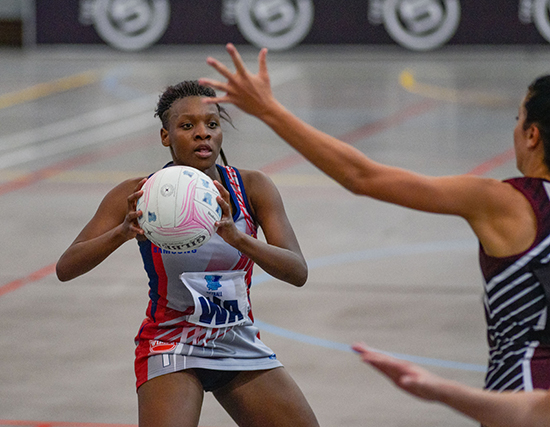Latest News Archive
Please select Category, Year, and then Month to display items
27 September 2018
Photo Varsity Sports
 Newly capped Protea Khanyisa Chawane will return for the Kovsies on Monday when they face the Maties in the semi-final of Varsity Netball in the Callie Human centre.
Newly capped Protea Khanyisa Chawane will return for the Kovsies on Monday when they face the Maties in the semi-final of Varsity Netball in the Callie Human centre.
A first ever Varsity Netball final in the Callie Human centre lie in what should the Kovsies cross the line this Monday in the semi-final against the Maties in Bloemfontein at 19:00.
Having ended first on the log, the Kovsies will enjoy home court advantage should they progress to the final on 8 October.
The Kovsies won their group fixture against the Maties last month in Stellenbosch by 59-56. It will be the first time the two teams clash in a knock-out match in the competition and also a first visit to the Callie Human centre for the Maties since 2013.
The Kovsies won six out of their seven group matches with their only loss against the Madibaz by a single goal.
They will be strengthened by the return of Khanyisa Chawane (centre) who missed a couple of matches whilst being in Australasia where she made her Protea debut. Meagan Roux, who can either play wing attack or goal attack, is also back. She travelled with the Proteas as a replacement.
They will however be without Tanya Mostert who will be on honeymoon. Her wedding is on Saturday. Remarkable it will only be the second time since her debut in the Kovsies’ very first match in the inaugural competition in 2013 that Mostert will miss a Varsity Netball match.
“The players really yearn to lift that trophy. It’s been some time since we last played in the final (in 2014). My message to them will be to give it their all on Monday,” Mostert said.
According to her the team is currently one that gels very nicely.
“Everyone fully understands their role in the team. We realized where our strengths lie and play according to it. Adding to that we play for one another.”
Dying of consumption: Studying ‘othering’ and resistance in pop culture
2014-10-31
 |
The Centre for Africa Studies (CAS) at the UFS – under the project leadership of Prof Heidi Hudson (CAS Director) – conceptualised an interdisciplinary research project on representations of otherness and resistance.
This is in collaboration with UFS departments such as the Odeion School of Music, the Department of Drama and Theatre Arts, the Department of Fine Arts, the Jonathan Edwards Centre Africa and the Department of Afrikaans and Dutch, German and French.
In this project, Dr Stephanie Cawood from CAS leads a sub-project on the dynamics of pop culture and consumerism. Her research unpacks and critiques pop culture representations of othering and resistance by engaging with the othering rhetoric of conspicuous consumption as well as the subversive rhetoric or culture jamming at play in various South African youth subcultures.
Consumerism has become the institutional system in which we live our daily lives. Pop culture is the result when multinational corporations take aspects of culture and turn it into commodities with high market value. In pop culture and its manifestation, consumption, marketers and savvy advertising executives have realised long ago that othering and resistance are powerful tools to artificially create empty spaces in people’s lives that can only be filled through consuming.
“The scary thing is in my opinion that everyone has become a market segment, including very young children,” says Dr Cawood.
In his 1934 book, The Theory of the Leisure Class (TLC), Thorstein Veblen coined the term conspicuous consumption to describe the conduct of the nouveau riche. He contended that when people manage to meet their basic human requirements, any additional accumulation of wealth will no longer relate to function, but will be spent on ostentatious displays of conspicuous consumption or waste. Conspicuous consumption has evolved into invidious consumption where consumption is a mark of one’s superior social status and particularly aimed at provoking envy. The whole point is unashamed one-upmanship.
“Think of the izikhotane or skothane cultural phenomenon where young people engage in ritualised and ostentatious consumerist waste for social prestige. This is an excellent example of invidious consumption.
“Instead of striving to become good citizens, we have become good consumers and none are more vulnerable than our youth irrespective of cultural and ethnic differences”.